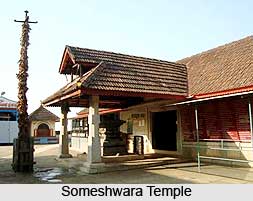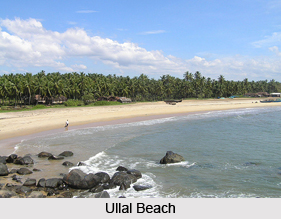 Ullal, located in Mangalore Taluk in Dakshina Kannada district of the Indian state Karnataka, is a city municipality. It is a little sea town nestled on the shores of Arabian Sea. It is famed as one of the oldest town of the country. The town still houses the relics of its glorious past at its beach as well as other parts. The small town lies at a distance of about 8 to 10 kilometres from Mangalore, near the border between the states of Karnataka and Kerala. It is located at an elevation of 5 metres. Major population of Ullal belong to either Mogaveera or Beary ethnic group.
Ullal, located in Mangalore Taluk in Dakshina Kannada district of the Indian state Karnataka, is a city municipality. It is a little sea town nestled on the shores of Arabian Sea. It is famed as one of the oldest town of the country. The town still houses the relics of its glorious past at its beach as well as other parts. The small town lies at a distance of about 8 to 10 kilometres from Mangalore, near the border between the states of Karnataka and Kerala. It is located at an elevation of 5 metres. Major population of Ullal belong to either Mogaveera or Beary ethnic group.
History of Ullal
In the 15th century Ullal was captured by the Portuguese. In the middle of 16th century, it served as the capital of Tulu Kingdom under the reign of Jain Queen, Rani Abbakka Devi. She was married to the Bangar King of Mangalore but their unsuccessful marriage made the queen return to the throne of Ullal which she had occupied after the death of her sister. Her worsened relation with her husband forced her to seek help of the powerful Raja of Bednore to save herself and the kingdom from her husband. With his support the queen defeated her husband in the war; however she lost the fertile tract of land at Berdatte to the Bednore King. The queen also had hostile terms with the Portuguese as the former was reluctant to pay the subsidy demanded by the Portuguese. With the help of her Moghveer and Beary warriors she also failed the Portuguese expedition. However, their defeat amplified their rage further and in a bloody massacre the Portuguese finally earned victory over the queen.
 Tourism in Ullal
Tourism in Ullal
The town of Ullal is also significant historically for sheltering a number of renowned monuments like Queen Abbakka"s Jain temple, Kadapara Jara Darga, Sayyid Madani Darga, Queen Abbakka"s Fort, Someshwara Temple and others. The ruins of Queen Abbakka"s Fort lie around the Someshwara Temple which still houses several artefacts belonging to the queen. The Jain temple also belongs to the queen. K. Pandyarajah Ballal Institute and College of Nursing and Summer Sands Beach Resort are other important landmarks of the town. The sea town has however suffered wide scale sea erosion in the recent years. To reduce the same, sand bags near the advancing coastline have been placed by the local authorities. Ullal serves as a significant trading centre. In the pre colonial era Ulla was one of the major ports of the western coast.
Ullal Beach
Ullal Beach is a pristine tourist destination known for its neat sea shore and serene ambience. The long stretch of golden sand and the refreshing breeze adds to the charm. The place is ideal for swimming and enjoying water sports. Sunsets are majestic at the beach. The picturesque beach is perfect for spending a peaceful time away from the cacophonies of life.



















